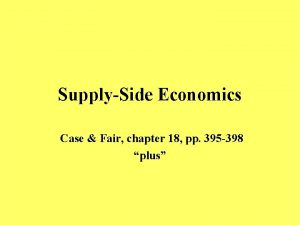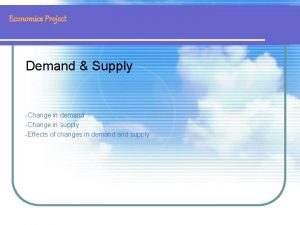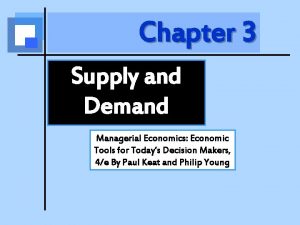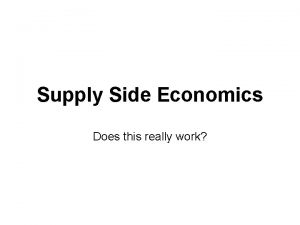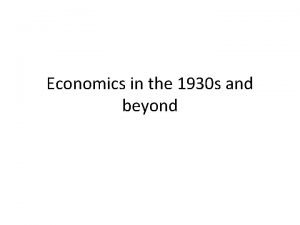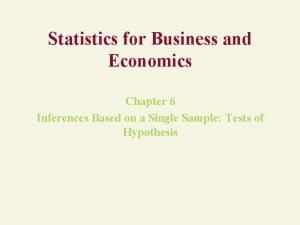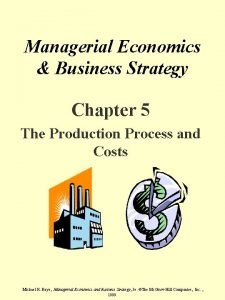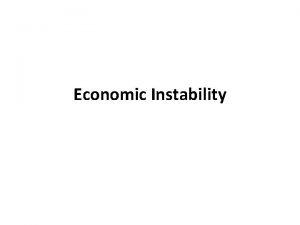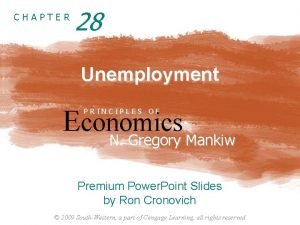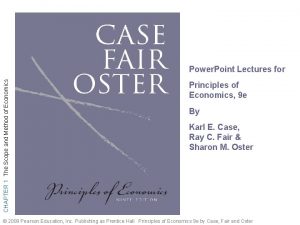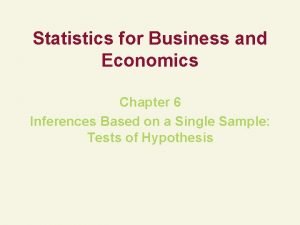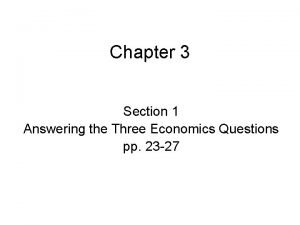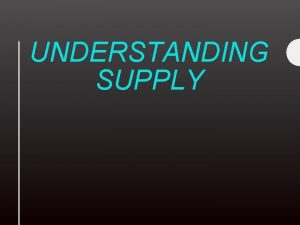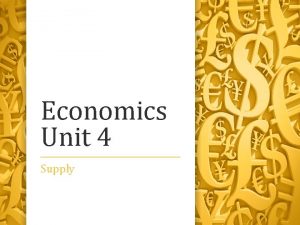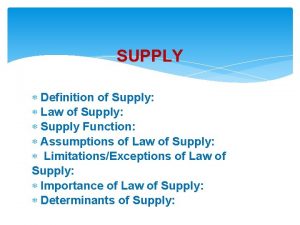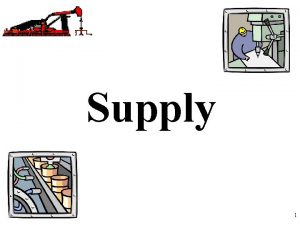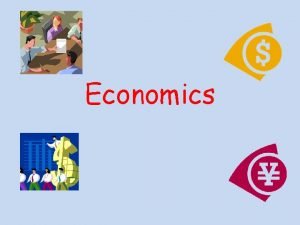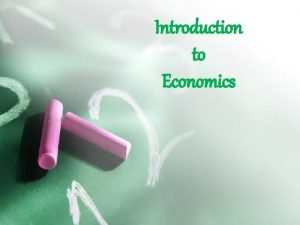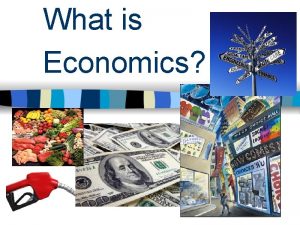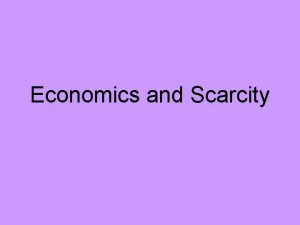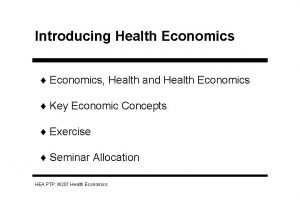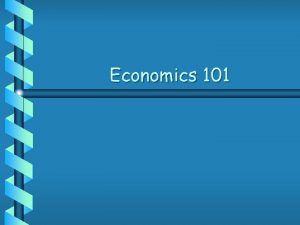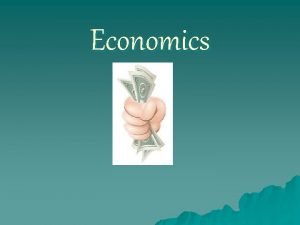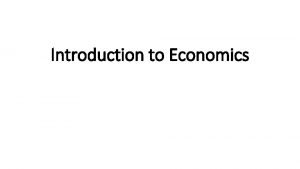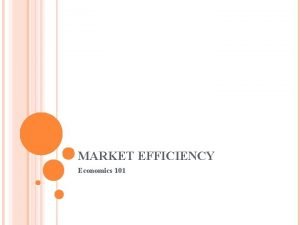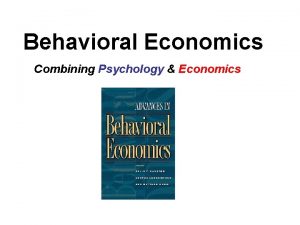Economics Chapter 5 Supply Supply What is supply



















- Slides: 19

Economics Chapter 5: Supply

Supply What is supply? • The amount of a product offered for sale at all possible prices that could prevail in the market. Please note: Suppliers must always consider the cost of production when pricing a product. • Firms will only produce a good or service if they can sell it at a price that will cover the cost to produce that good or service. •

Law of Supply What is the Law of Supply: The principle that states a positive relationship exists between price of a good and the quantity supplied of that good; ceteris paribus. • Suppliers will offer more of a good for sale at higher prices and less at lower prices. • A Visual Definition: Price Supply

Demand Curves vs. Schedules Supply Schedule • A table that shows how much a producer will supply at all possible prices.

Demand Curves vs. Schedules Supply Curve • A graph that shows the different amounts of a product supplied over a range of possible prices Market Supply Curve • A graph that shows the different amounts of a product offered at various prices by all firms in the market for that product.

Change in Quantity Supplied What is a change in quantity supplied? • A change in the number of units being offered for sale • due to a change in the price of the good being offered. A movement along the supply curve. Example: • • • If the price of a gallon of milk is $3, then only 3 gallons will be supplied. However, if the price rises to $6, then 6 gallons will be supplied. This means there is a rightward movement along the supply curve.

Change in Supply What is a change in supply? • • • A change in the amount of a good suppliers are willing and able to sell due to a change in a condition other than the good’s price A situation where suppliers offer different amounts of a good for sale at all possible prices in the market. A shift in the supply curve itself.

Change in Supply A decrease in supply An increase in supply

Change in Supply What causes a change in supply? 1. 2. 3. 4. 5. 6. 7. Changes in cost of resources Changes in productivity Changes in technology Changes in taxes and subsidies Changes in expectations Changes in government regulations Changes in the number of sellers

Change in Cost of Resources • If the cost of one of the inputs of production increases, then the supply for the product being produced will fall. • Inputs of productions = land, labor, capital • Example: If the price of flour rises, then we can expect the supply of bread to fall because of the increase in the cost of production. • Input prices Supply

Change in Productivity • Productivity increases whenever more output is produced using the same amount of input. • Example: productivity increases if managers train their workers better or if workers are motivated to work harder. • Productivity Supply

Change in Technology • The introduction of new technology tends to lower the cost of production and allows for an increase in productivity; both lead to and increase in supply. • GPS units in delivery trucks help drivers be more efficient (less gas is wasted and more time is saved) * If technology increases, then supply increases.

Change in Taxes and Subsidies • If the government changes the tax rates or policies regarding subsidies then the cost of production will change as well. Thus, supply will either increase of decrease depending on the change. • • Firms view taxes as a cost of production Subsidies are government payments to either encourage or protect a certain economic activity • Example: Milk producers receive a subsidy to support their income which increases their ability to produce. • Taxes Supply • Subsidies Supply

Change in Expectations If producers expect the price of their product to increase, they make plans to produce more so supply will increase. • If producers expect the price of their product to decrease they may try to produce something else or even stop producing altogether which causes supply to fall. • Expectations can also affect the price firms plan to pay for some of the inputs used in production. •

Change in Government Regulations • When the government establishes new regulations, the cost of production can change which causes a change in supply. • Increased regulations causes supply to be more restricted • Example: when the government requires automakers to add more safety features to their vehicles the cost of production increases and therefore they supply fewer cars at each price • Government Regulation Supply

Change in the Number of Sellers • If the number of sellers increases, then supply also increases and vice versa • Firms entering or leaving a market • Reasons why firms choose to enter a market include: profit motive and an enlarging customer base. • New firms join an industry because they see the potential for large profits. This causes supply to increase.

Elasticity of Supply What is elasticity of supply? • The measure of the responsiveness of the quantity supplied to changes in the product’s price. • Price Elasticity of Supply = % change in Qs % change in P Example: if gasoline increases in price from $3 to $4, then supply for gas increases by 5% PE = 5% / 33% = 0. 15 The price elasticity for gas is 0. 15 Therefore, supply for gasoline is price inelastic

Elasticity of Supply • If PE is greater than one, then supply is price elastic • If PE is less than one, then supply is price inelastic • If PE is equal to one, then supply is unitary price elastic

Determinants of Supply Elasticity • The elasticity of a producer’s supply curve depends on the nature of its production. • If a firm quickly react to new prices, then supply is likely to be elastic. • If the firm takes awhile to react to new prices, then supply is likely to be inelastic • Examples: • Farm commodities are inelastic once the planting season is over. If the price or corn were to double, have to wait until next spring before they can produce more of it. • Candy is a good that is considered to be elastic because it can be made quickly without huge investments in capital and labor.
 Maastricht university school of business and economics
Maastricht university school of business and economics Elements of mathematical economics
Elements of mathematical economics Chapter 5 section 1 supply
Chapter 5 section 1 supply Keynesian vs supply side
Keynesian vs supply side Supply and demand economics project
Supply and demand economics project Supply curve economics
Supply curve economics Supply and demand economics project
Supply and demand economics project Determinants of demand in managerial economics
Determinants of demand in managerial economics Supply side economics
Supply side economics New classical macroeconomics
New classical macroeconomics Demand side economics
Demand side economics Statistics for business and economics chapter 6 solutions
Statistics for business and economics chapter 6 solutions Managerial economics chapter 5
Managerial economics chapter 5 Chapter 13 economic instability
Chapter 13 economic instability Chapter 28 unemployment
Chapter 28 unemployment The scope and method of economics chapter 1
The scope and method of economics chapter 1 What is the ha
What is the ha Answering the three economic questions
Answering the three economic questions Chapter 1 ten principles of economics
Chapter 1 ten principles of economics The dynamics of business and economics
The dynamics of business and economics



